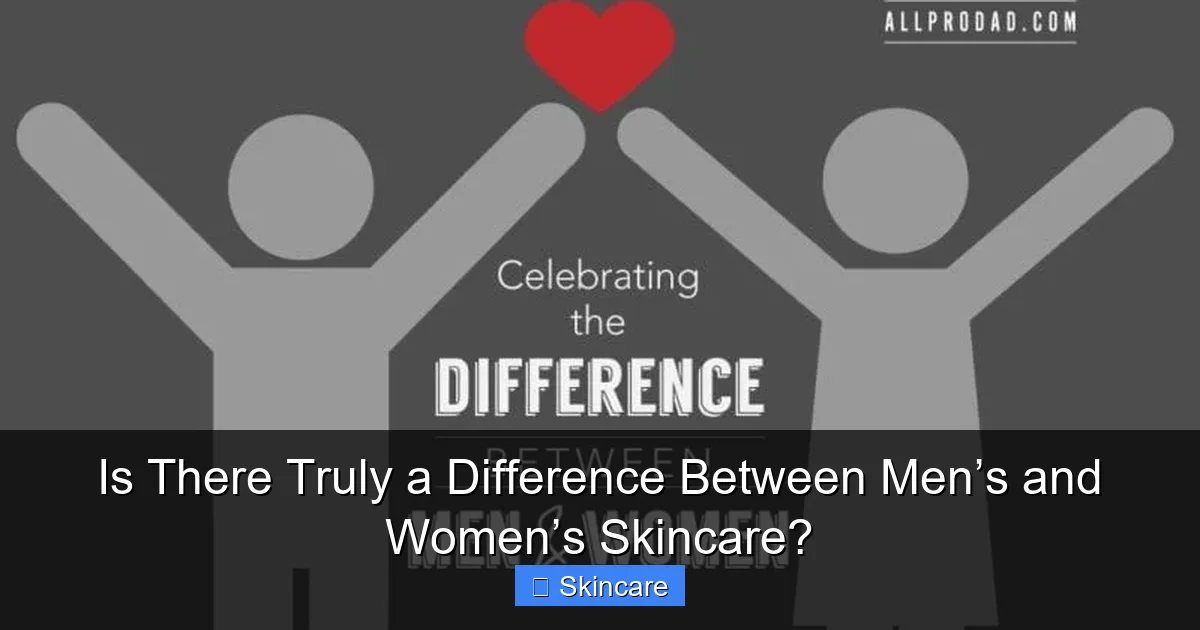
Featured image for this comprehensive guide about is there a difference between men and women skincare
Image source: elite.nyc3.digitaloceanspaces.com
Step into any skincare aisle, and you’re immediately confronted with a sea of products meticulously categorized: pink, pastel, and floral for “her,” and dark, rugged, and woody for “him.” This clear distinction begs the age-old question: Is there truly a fundamental difference between men’s and women’s skincare, or is it mostly clever marketing? While societal norms and beauty industry segmentation play a significant role, the science of our skin does reveal some intriguing biological nuances. But do these nuances warrant entirely separate product lines and skincare routines?
For years, the narrative has been that men and women have inherently different skin needs requiring specialized formulas. In this comprehensive guide, we’ll delve beyond the branding to explore the biological truths, debunk common myths, and ultimately empower you to choose the most effective products for your unique skin, regardless of gender.
📋 Table of Contents
- The Science Behind Skin: Are Men and Women Really Different?
- Decoding Product Formulations: Is There a True Gender Divide?
- Marketing vs. Biology: The Skincare Industry’s Role
- Tailoring Your Skincare: Focus on Skin Type, Not Gender
- Building an Effective, Gender-Agnostic Skincare Routine
- Conclusion: Focus on Your Skin, Not the Label
The Science Behind Skin: Are Men and Women Really Different?
When it comes to our largest organ, the skin, there are indeed some measurable biological distinctions between the sexes. These differences are largely influenced by hormones, genetics, and lifestyle factors. Understanding these can help explain why certain skin concerns might be more prevalent in one gender than the other, but importantly, not exclusive.
Skin Thickness and Collagen Density
- Thickness: On average, male skin is about 20-25% thicker than female skin. This is due to a higher concentration of collagen and elastin.
- Collagen: Men generally have a higher collagen density, which contributes to firmer skin and often results in a slower onset of visible aging, such as fine lines and wrinkles. However, once wrinkles do appear in men, they can often be deeper and more pronounced.
Oil Production and Pore Size
- Sebum Production: Androgens, like testosterone, stimulate the sebaceous glands, leading to larger pores and higher sebum (oil) production in men. This often makes oily skin and acne more common issues for men, even into adulthood.
- Pore Size: Consequently, men typically have larger and more visible pores compared to women.
- Hormonal Fluctuations: While men’s oil production tends to be more consistent, women experience significant fluctuations due to menstrual cycles, pregnancy, and menopause, which can impact oiliness and breakouts.
Hormonal Influences on Aging
Women’s skin is particularly susceptible to hormonal shifts, especially during menopause. The significant drop in estrogen levels during this period leads to a rapid decrease in collagen production, causing increased dryness, loss of elasticity, and accelerated wrinkle formation. Men, whose hormone levels decline more gradually with age, tend to experience a more linear aging process.
| Skin Characteristic | Typical Male Skin Profile | Typical Female Skin Profile |
|---|---|---|
| **Skin Thickness** | Approximately 20-25% thicker on average, with a denser collagen network. | Generally thinner and more delicate compared to male skin. |
| **Sebum Production** | Higher sebaceous gland activity, leading to more oil production and larger pores. Often prone to acne. | Lower sebum production, generally less oily and smaller pores. Often prone to dryness. |
| **Collagen Density** | Higher collagen density, contributing to a firmer appearance and potentially slower onset of fine lines. | Lower collagen density, which can lead to earlier visible signs of aging like fine lines and loss of firmness. |
| **Facial Hair & Shaving** | Presence of facial hair (beard) and regular shaving often causes irritation, micro-cuts, and can disrupt the skin barrier. | Absence of thick facial hair; facial shaving is less common, leading to different exposure to physical irritants. |
| **Aging Process** | Tends to form deeper, more pronounced wrinkles later. Sagging may appear more abruptly. | Prone to earlier formation of fine lines and overall loss of elasticity, with more gradual sagging and volume loss. |
Hair Growth and Shaving
One of the most significant lifestyle differences impacting men’s skincare is daily shaving. This routine can lead to:
- Increased irritation and inflammation.
- Micro-cuts and nicks.
- Ingrown hairs (pseudofolliculitis barbae).
- A compromised skin barrier, making skin more susceptible to dryness and sensitivity.
These unique challenges often necessitate specific soothing, hydrating, and protective products tailored for post-shave care.
Decoding Product Formulations: Is There a True Gender Divide?
Beyond the biological skin differences, much of what we perceive as “gendered” skincare boils down to marketing and consumer preferences. When you strip away the packaging and fragrance, many core ingredients found in both men’s and women’s skincare are identical and universally effective.

Learn more about is there a difference between men and women skincare – Is There Truly a Difference Between Men’s and Women’s Skincare?
Image source: allprodad.com
- Universal Actives: Ingredients like hyaluronic acid (for hydration), retinol (for anti-aging), Vitamin C (for brightening and antioxidants), ceramides (for barrier repair), and SPF (for sun protection) work the same way on all human skin, regardless of gender.
- Texture Preferences: Traditionally, men’s products might be formulated with slightly thicker textures (gels, balms) or be less fragranced, while women’s products often feature lighter, more elegant textures (serums, lotions) and a broader range of scents. These are largely aesthetic choices, not efficacy requirements.
- Fragrance: A major differentiator is scent. Men’s products typically feature “masculine” fragrances (sandalwood, musk, mint), while women’s often lean towards floral, fruity, or sweet notes. For those with sensitive skin, or simply a preference for simplicity, fragrance-free options are always the best choice, regardless of gender.
Marketing vs. Biology: The Skincare Industry’s Role
The skincare industry has historically excelled at creating distinct product lines for men and women, primarily driven by marketing strategies rather than absolute biological necessity. This segmentation aims to resonate with gender identity and perceived needs.

Learn more about is there a difference between men and women skincare – Is There Truly a Difference Between Men’s and Women’s Skincare?
Image source: barnorama.com
- Targeted Messaging: Advertising for men’s skincare often emphasizes simplicity, strength, and anti-fatigue benefits, while women’s skincare campaigns may focus on anti-aging, radiance, and specific beauty ideals.
- Packaging and Aesthetics: The visual cues are undeniable. Darker, minimalist packaging for men; lighter, more decorative packaging for women. This creates an immediate psychological distinction, guiding consumer choices based on gender rather than actual skin type or concern.
- The Rise of Gender-Neutral Skincare: Increasingly, consumers are becoming more ingredient-savvy and less swayed by traditional gender marketing. This has led to a boom in “unisex” or gender-neutral skincare brands that focus purely on the efficacy of ingredients and solving specific skin concerns, appealing to anyone and everyone. This shift highlights a growing understanding that skin is skin, and its needs are universal at a fundamental level.
Tailoring Your Skincare: Focus on Skin Type, Not Gender
The most crucial takeaway is this: your skincare routines should be dictated by your individual skin type, concerns, and lifestyle, not by your gender. While biological differences provide a baseline, they don’t prescribe an entire regimen. Instead, think about what your skin *needs*.
Oily Skin Needs
Characterized by excess shine, visible pores, and a propensity for breakouts. This can be common in men due to higher testosterone levels, but many women also experience oily skin.
Key Ingredients: Salicylic acid, niacinamide, clay, tea tree oil.
Product Focus: Lightweight gels, oil-free formulas, mattifying products.
Dry/Dehydrated Skin Needs
Feels tight, flaky, and lacks moisture. More prevalent in women, especially post-menopause, but men can also have naturally dry skin or experience dehydration from environmental factors.
Key Ingredients: Hyaluronic acid, ceramides, glycerin, squalane, shea butter.
Product Focus: Creamy cleansers, rich moisturizers, hydrating serums, facial oils.
Sensitive Skin Needs
Prone to redness, irritation, and allergic reactions. This affects both genders equally and requires gentle care.
Key Ingredients: Centella asiatica (Cica), colloidal oatmeal, allantoin, panthenol.
Product Focus: Fragrance-free, alcohol-free, minimal ingredient lists, soothing formulas.
Anti-Aging Concerns
Fine lines, wrinkles, loss of firmness, and hyperpigmentation are universal signs of aging.
Key Ingredients: Retinoids, Vitamin C, peptides, antioxidants, SPF.
Product Focus: Serums, targeted treatments, daily broad-spectrum sunscreen.
Building an Effective, Gender-Agnostic Skincare Routine
An effective daily skincare routine follows fundamental steps that benefit all skin, regardless of gender. The specific products within each step are then chosen based on individual skin needs. Here’s a universal framework:
- Cleanse: Start with a gentle cleanser twice daily to remove dirt, oil, and impurities without stripping the skin. For those who shave, a hydrating cleanser can prepare the skin without over-drying.
- Treat (Serums & Actives): After cleansing, apply targeted treatments. This is where you address specific concerns like acne, dryness, aging, or redness. Examples include a Vitamin C serum in the morning or a retinol serum at night.
- Moisturize: Apply a moisturizer to hydrate and strengthen the skin barrier. Choose a texture appropriate for your skin type – a lightweight gel for oily skin, a richer cream for dry skin.
- Protect (SPF): This step is non-negotiable for everyone. Apply a broad-spectrum sunscreen with at least SPF 30 every morning, rain or shine. UV protection is the most effective anti-aging and skin health strategy.
Consistency is key. Whether you identify with men’s skincare or women’s skincare, sticking to a routine that suits your skin’s biological profile and concerns will yield the best results.
Conclusion: Focus on Your Skin, Not the Label
The world of skincare, while often segmented by gender, is ultimately a shared space for achieving healthy, radiant skin. While biological skin differences between men and women do exist—primarily in thickness, oil production, and hormonal influences—these differences are nuances that inform individual needs, rather than creating an impenetrable gender divide in product efficacy. Most active ingredients work universally, and the real distinctions often lie in marketing, fragrance, and packaging.
The most effective approach to skincare is one that listens to your skin. Embrace the rise of gender-neutral skincare and look beyond the blue and pink bottles. Focus on understanding your skin type, identifying your specific concerns, and selecting ingredients that deliver proven results. By prioritizing personalized care over traditional gender labels, you’ll discover a world of effective skincare routines that truly cater to you, ensuring your skin receives exactly what it needs to thrive.
🎥 Related Video: Indian Skincare VS Normal Skincare
📺 theriaamin
Do Subscribe FOLLOW ME ON INSTAGRAM – http://www.instagram.com/theriaamin/ Contact Here For Collaborations …
Frequently Asked Questions
Is there a fundamental difference in skin biology between men and women?
Yes, there are distinct biological differences between men’s and women’s skin. Men’s skin is typically thicker, has larger pores, produces more sebum (oil) due to higher testosterone levels, and has a richer collagen density. Women’s skin tends to be thinner, experiences more hormonal fluctuations, and shows signs of aging differently due to estrogen decline.
Do men and women truly need different skincare products?
While there are biological distinctions in men’s and women’s skin, the necessity for entirely different skincare product formulations is often overstated. Both genders benefit from products designed to address specific concerns like acne, dryness, sensitivity, or anti-aging. The most effective approach is to choose products based on your individual skin type and specific concerns, rather than solely on gender.
Can men use skincare products marketed for women, and vice versa?
Absolutely! Skincare products are not inherently gender-specific, despite how they are often marketed. If a product effectively addresses your personal skin type and concerns—be it oily, dry, sensitive, or aging—it will work for you regardless of the gender it’s advertised for. Focus on the ingredients and what your skin needs, not the packaging or scent.
Why are so many skincare products specifically marketed as “men’s” or “women’s”?
Marketing plays a significant role in differentiating “men’s” and “women’s” skincare lines. Brands often create gender-specific packaging, scents, and messaging to appeal to particular demographics and create distinct product categories. While some men’s products might contain ingredients to soothe shaving irritation or have a more neutral fragrance, the core active ingredients for skin health are largely universal.
What are the actual biological differences between men’s and women’s skin that might influence skincare choices?
Men’s skin generally has a lower pH, making it more acidic, and it produces more sweat and sebum, leading to a higher likelihood of oiliness and breakouts. Women’s skin, influenced by hormonal cycles, can fluctuate in hydration and sensitivity, and it tends to show collagen loss and fine lines more visibly post-menopause. These distinctions can influence product preferences and specific ingredient needs for men’s and women’s skincare routines.
Should I choose my skincare based on my gender or my specific skin type and concerns?
You should always prioritize your individual skin type and specific concerns over your gender when choosing skincare. Whether you have oily, dry, sensitive, combination, or aging skin, select products with ingredients that directly target those issues. Your unique skin biology and environmental factors are far more influential than your gender in determining effective men’s and women’s skincare solutions.
